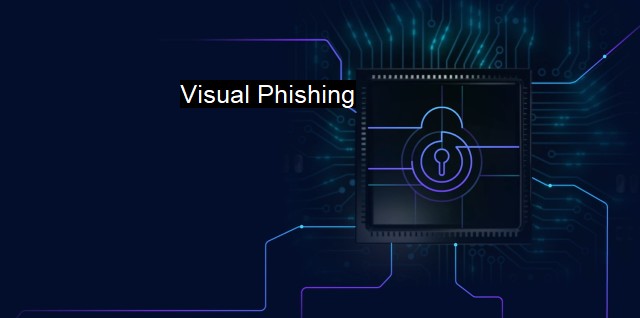What is Visual Phishing?
Deceptive Designs: Understanding Visual Phishing and Its Role as an Advanced Cyber Attack
Visual phishing, also known as UI redressing, is a type of online threat prevalent in our increasingly digital society. A subgroup of the broader category of phishing, visual phishing is a deceptive technique employed by cybercriminals wherein they replicate or mimic legitimate and trustworthy websites, emails, or various other interfaces appealing to users, to trick them into disclosing their critical personal information.Visual phishing can be performed via many methods. This could involve an email sent that appears to come from a reputable organization such as a bank or credit card company, asking the recipient to click on a link to update their security details or password. By clicking on this link, the recipient is redirected to a counterfeit version of the official site, designed so meticulously that it is almost impossible to discern the two. Not suspecting any foul play, the user tries to 'update' their security details or password, essentially handing them over to criminals.
The phenomenon of visual phishing is situated in the broad canopy of cybersecurity issues. Within this context, it exists as one of facilitating factors giving momentum to imminent cyber threats. As digitalization increases and online activities become more complex, there exist massive repositories of sensitive data online, and visual phishing has grown into an urgent issue that raises significant concerns about privacy and security.
The objective of visual phishing is quite straightforward: perpetrating cyber deception to procure classified personal and financial information from unsuspecting users. The magnitude of the information that could potentially be stolen through visual phishing is extensive: such as usernames, passwords, credit card numbers, social security numbers, etc.
Criminals are becoming increasingly sophisticated in choosing their targets and deploying their attacks, making for a dynamic and continually evolving problem. As technology advances, cybercriminals invent more sophisticated iterations of this malicious technique, thereby making visual phishing attacks become increasingly convincing, finer-tuned, and harder to defend against and discover.
In contemporary cybersecurity narratives, anti-virus software and other defensive systems play a vital role in combating visual phishing threats. Most current defensive mechanisms employ multiple layers of protection to avert such attacks. These might encompass anti-spam filters, encryption tools, firewall protections, and many other security features. They scrutinize links and sites users interact with, detect any phishing attempts, and block them when necessary.
Another essential defensive mechanism is the integration of machine learning and artificial intelligence in latest antivirus software. AI-powered antiviruses enhance threat detection capabilities using sophisticated algorithms to recognize phishing attempts, thereby significantly enhancing cybersecurity. They can detect anomalies, examine the behavioral pattern of sites and email senders, thereby validating their authenticity and ensuring users’ safety.
Paradoxically, the first line of defense against visual phishing remains the users themselves. Awareness and education around the omnipresent dangers of phishing attacks are of paramount importance. Regular users must be taught how to spot potential threats, suspicious email elements, and malicious websites, thereby promoting a more secure cyber environment.
Cybersecurity threats, such as visual phishing, are far from being fully mitigated. With each passing day, cybercriminals are coming up with new variants of attacks that are constantly evading cybersecurity measures and the constant challenge lies in creating sophisticated countermeasures to keep up with these threats.
Regardless of the uphill task, both public entities, private organizations and individuals should stay vigilant; continuously invest in high-quality antivirus software that regenerously updates to match the enemy’s tactics; and foster a culture of continuous learning and awareness about cyber threats. In achieving this sustained commitment to tackle visual phishing, online users can browse websites with relative tranquility, confident in the ability of their firewalls and anti-virus software to ward off these malicious attacks.

Visual Phishing FAQs
What is visual phishing?
Visual phishing is a type of cyber attack where scammers use fake websites, emails or pop-ups with convincing graphics and interfaces to trick users into revealing sensitive or confidential information.How does visual phishing work?
Visual phishing works by persuading users to click on malicious links or attachments that appear to be legitimate. Once the user clicks on the link or attachment, scammers can gain access to sensitive data such as login credentials, credit card details or other confidential information.What are the consequences of falling for visual phishing scams?
The consequences of falling for visual phishing scams can be severe, including identity theft, financial fraud, and damage to reputation. Scammers can use the information they obtain to steal money or mimic the user's identity for other malicious activities.How can I protect myself from visual phishing attacks?
To protect yourself from visual phishing attacks, it is essential to be vigilant and cautious when clicking links or attachments. Avoid opening suspicious emails or files, and always verify the authenticity of the sender before disclosing any personal information. Using antivirus software, updating your software regularly, and enabling two-factor authentication can help you stay protected from visual phishing scams.| | A | | | B | | | C | | | D | | | E | | | F | | | G | | | H | | | I | | | J | | | K | | | L | | | M | |
| | N | | | O | | | P | | | Q | | | R | | | S | | | T | | | U | | | V | | | W | | | X | | | Y | | | Z | |
| | 1 | | | 2 | | | 3 | | | 4 | | | 7 | | | 8 | | |||||||